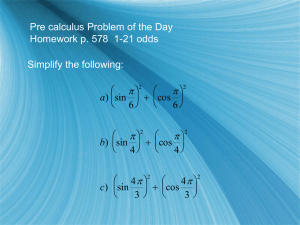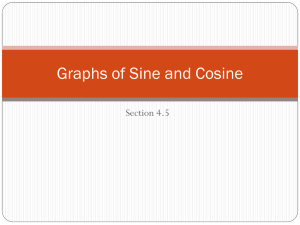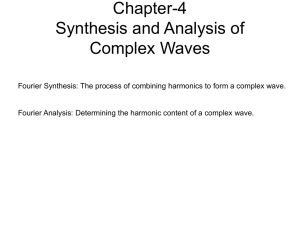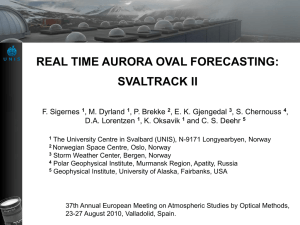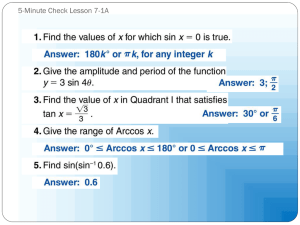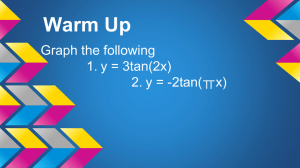Fourier Analysis_ppt
advertisement
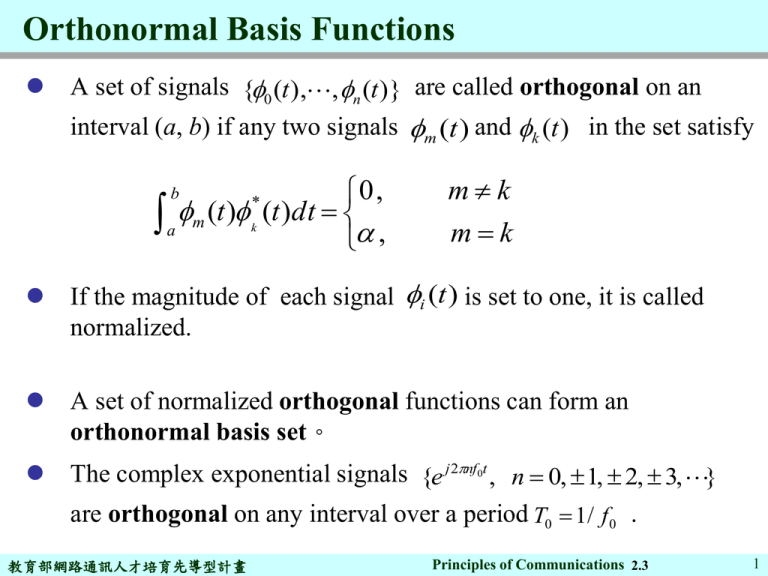
Orthonormal Basis Functions
A set of signals {0 (t ),, n (t )} are called orthogonal on an
interval (a, b) if any two signals m (t ) and k (t ) in the set satisfy
0,
a m (t ) k (t )dt ,
b
*
mk
mk
If the magnitude of each signal i (t ) is set to one, it is called
normalized.
A set of normalized orthogonal functions can form an
orthonormal basis set。
The complex exponential signals {e j 2nf t , n 0, 1, 2, 3, }
are orthogonal on any interval over a period T0 1/ f0 .
教育部網路通訊人才培育先導型計畫
0
Principles of Communications 2.3
1
Generalized Transformation of Signal
A signal x(t) on any interval over a period T0, i.e., (t0 , t0+T0 ), can
be expressed as following in terms of {0 (t ),, n (t ),}
x(t ) cnn (t ), t0 t t0 T0
n 0
1
cn
T0
t0 T0
t0
x(t ) n* (t )dt
Parseval theorem:(Will be discussed later)
1
P
T0
T0
x(t ) dt |cn |2 ,
2
教育部網路通訊人才培育先導型計畫
n 0
T0
: Integrate over a period.
Principles of Communications 2.3
2
Fourier theory
Jean Baptiste Joseph Fourier (1768-1830) proposed that a periodic signal can
be represented by a summation of a (possibly infinite) number of sinusoids each
with a particular amplitude and phase.
Assume that x(t) is a periodic signal with fundamental period T0, then x(t) can
be represented as
x(t ) a0 [an cosn0t bn sin n0t ],
n 1
or
x(t ) a0 [an cos 2nf0t bn sin 2nf0t ],
n 1
0 2f 0
2
T0
The series is called Trigonometric Fourier series because it is represented in
terms of sinusoids.
教育部網路通訊人才培育先導型計畫
Signals and Systems 4.3
3
Coefficients of trigonometric Fourier series (1/7)
Given a periodic signal with fundamental period T0 that can be represented by
the trigonometric Fourier series
x(t ) a0 [an cos n0t bn sin n0t ]
n 1
The problem is how to find the coefficients a0, an and bn.
We begin with a0
Integrating the series term by term over one period T0, we obtain
T0
x(t )dt
T0
0
0
a0 dt a1 cos0tdt a2 cos 20tdt
T0
T0
b1 sin 0tdt b2 sin 20tdt
T0
T0
0
0
Note:Integrating the sinusoidal over one or integer number of periods is 0.
教育部網路通訊人才培育先導型計畫
Signals and Systems 4.3
4
Coefficients of trigonometric Fourier series (2/7)
T0
x(t )dt a0T0
1
a0
T0
T0
x(t )dt
a0 is the average value of
the waveform (signal).
Find coefficients an
Multiplying both sides of the series equation by cos k0t and integrating
over one period T0, we obtain
a0 cos k0tdt an cos n0t cos k0tdt
T0 x(t ) cosk0tdt T0
T0 n 1
0
bn sin n0t cos k0tdt
T0
n 1
教育部網路通訊人才培育先導型計畫
Signals and Systems 4.3
5
Coefficients of trigonometric Fourier series (3/7)
x(t ) cos k0tdt [an cos n0t cos k0tdt bn sin n0t cos k0t dt]
T0
T0
T0
n 1
I1 0
T0 n k
I3 0
nk
2
The terms I1 and I3 will be
discussed in details later
T0
x(t ) cos k0tdt ak
T0
2
2
2
ak x(t ) cos k0tdt an
T0 T0
T0
教育部網路通訊人才培育先導型計畫
T0
x(t ) cos n0tdt
Signals and Systems 4.3
6
Coefficients of trigonometric Fourier series (4/7)
Find coefficients bn
Similarly we can obtain
x(t ) sin k0tdt a0 sin k0tdt an cos n0t sin k0tdt
T0
T0
T0 n 1
0
bn sin n0t sin k0tdt
T0
n 1
x(t ) sin k0tdt [an cosn0t sin k0tdt bn sin n0t sin k0t dt]
T0
T0
T0
n 1
I1 0
x(t ) sin k0tdt bk
T0
2
bk
T0
T0
T0
2
x(t ) sin k0tdt
教育部網路通訊人才培育先導型計畫
0 nk
I 2 T0
nk
2
2
bn
T0
I2 will be discussed
in details later
T0
x(t ) sin n0tdt
Signals and Systems 4.3
7
Coefficients of trigonometric Fourier series (5/7)
In the procedure of finding coefficients an and bn , we used the properties of
integrals involving products of sines and cosines.
Consider
I1 cosn0t sin k0tdt
T0
0
0
1
n
k
,
I
[ sin( n k )0tdt sin( n k )0tdt ] 0
If
1
T0
2 T0
1
If n k , I1 cos k0t sin k0tdt sin 2k0tdt 0
T0
2 T0
I1 cosn0t sin k0tdt 0
T0
教育部網路通訊人才培育先導型計畫
Signals and Systems 4.3
8
Coefficients of trigonometric Fourier series (6/7)
Consider
I 2 sin n0t sin k0tdt
T0
If
n k,
0
0
1
I 2 [ cos( n k )0tdt cos( n k )0tdt ] 0
T0
2 T0
If
n k,
I 2 sin k0t sin k0tdt sin 2 k0tdt
T0
T0
0
1 cos 2k0t
T0
1
1
dt dt cos 2k0tdt
T0
T0 2
T0 2
2
2
0, n k
I 2 T0
2 , nk
教育部網路通訊人才培育先導型計畫
Signals and Systems 4.3
9
Coefficients of trigonometric Fourier series (7/7 )
Consider
I 3 cos n0t cosk0tdt
T0
If
n k,
If
n k,
0
0
1
I 3 [ cos( n k )0tdt cos( n k )0tdt ] 0
T0
2 T0
1 cos 2k0t
I 3 cos k0tdt
dt
T0
T0
2
0
T0
1
1
dt cos 2k0tdt
T0 2
T0 2
2
2
0, n k
I 3 T0
2 , nk
教育部網路通訊人才培育先導型計畫
Signals and Systems 4.3
10
Trigonometric Fourier series
Given a periodic signal with period T0 that can be represented by the
trigonometric Fourier series,
x(t ) a0 [an cos n0t bn sin n0t ]
n 1
where
1
a0
T0
x(t )dt
T0
the average value of the signal
2
an
T0
x(t ) cos n0tdt
2
bn
T0
x(t ) sin n0tdt
教育部網路通訊人才培育先導型計畫
T0
T0
n0
n0
Signals and Systems 4.3
11
Harmonic form Fourier series
By using the Trigonometric equality
an cosn0t bn sin n0t cn cos(n0t n )
where
we have
cn an bn ;
2
2
n tan1 (
bn
)
an
x(t ) a0 (an cos n0t bn sin n0t )
n 1
a0 cn cos(n0t n )
n 1
Let c0 = a0 and we have the harmonic form Fourier series of x(t)
x(t ) c0 cn cos(n0t n )
n 1
教育部網路通訊人才培育先導型計畫
Signals and Systems 4.3
12
Limits of Fourier series at the discontinuities
The Fourier series of waveform converges to the mean of the right- and lefthand limits at the discontinue point.
x(t ) a0 (an cos n0t1 bn sin n0t1 )
n 1
x(t )
limits of Fourier series
b
x(t1 ) a or b
a
Discontinue at t = t1+ nT0
t1 T0
t1
t1 2T0
t1 3T0
t
Limits of Fourier series
ab
a0 (an cos n0t1 bn sin n0t1 )
2
n 1
教育部網路通訊人才培育先導型計畫
Signals and Systems 4.3
13
Dirichlet conditions for Fourier series
A periodic signal x(t) can be represented as a Fourier series only if it
satisfy the following Dirichlet conditions:
x(t) is absolutely integrable over any period, that is
t1 T0
t1
x(t ) dt , for any t1
x(t) has a finite number of maxima and minima within any finite interval of t.
x(t) has a finite number of discontinuities within any finite interval of t, and
each of these discontinuities is finite.
教育部網路通訊人才培育先導型計畫
Signals and Systems 4.3
14
Example 4-9 (1/6)
Please find the trigonometric Fourier series for the periodic
rectangular pulse train signal with period 2.
x(t)
1
3
2
教育部網路通訊人才培育先導型計畫
/2 /2
2
3
Signals and Systems 4.3
t
15
Example 4-9 (2/6)
【Sol.】
1) The trigonometric Fourier series with 0 = 2 /T0= 2 /2 = 1
x(t ) a0 [an cos nt bn sin nt]
n 1
2) Find a0
1
a0
T0
教育部網路通訊人才培育先導型計畫
1
T0 x(t )dt 2
2
2
1
1dt
2
Signals and Systems 4.3
16
Example 4-9 (3/6)
3) Find an
2
an
T0
T0
x(t ) cos ntdt
2
n
cos ntdt
sin( )
2
n
2
1
2
0,
2
,
n
2
,
n
教育部網路通訊人才培育先導型計畫
n is even
n 1,5,9,13,...
n 3,7,11,15,...
Signals and Systems 4.3
17
Example 4-9 (4/6)
4) Find bn
2
bn
T0
T0
x(t ) sin ntdt
5) The signal x(t) is written by
x(t )
1
2
sin ntdt 0
2
cos x cos(x )
1 2
1
1
1
(cos t cos 3t cos 5t cos 7t ...)
2
3
5
7
1 2
1
1
1
[cost cos(3t ) cos5t cos(7t ) ...]
2
3
5
7
c0 cn cos(nt n )
n 1
教育部網路通訊人才培育先導型計畫
Signals and Systems 4.3
18
Example 4-9 (5/6)
6) The trigonometric Fourier series for the periodic rectangular pulse train
signal with period 2 is obtained.
x(t ) c0 cn cos(nt n )
n 1
1
2
0,
cn 2
,
n
,
n
0,
c0
教育部網路通訊人才培育先導型計畫
n is even
n is even
n 3,7,11,15,...
else
Signals and Systems 4.3
19
Example 4-9 (6/6)
Plot the series in frequency domain.
1 2
1
1
1
x(t ) [cos t cos( 3t ) cos 5t cos( 7t ) ...]
2
3
5
7
Note: The phases are either 0 or ,
cne jn
教育部網路通訊人才培育先導型計畫
the amplitude and phase are
combined in this special case.
Signals and Systems 4.3
20
Example 4-10 (1/6)
Please find the trigonometric Fourier series for the periodic
triangle pulse train signal with period 2.
x(t )
A
0
t
A
教育部網路通訊人才培育先導型計畫
Signals and Systems 4.3
21
Example 4-10 (2/6)
【Sol.】
1) The trigonometric Fourier series with 0 = 2 /T0= 2 /2 = .
x(t ) a0 [an cos nt bn sin nt]
n 1
2) Set the period as [1/2, 3/2], then x(t) in this period is written as
2 At,
x(t )
2 A(1 t ),
1
t
2
1
3
t
2
2
3) Obtain a0 = 0 . (the average of x(t) is 0)
教育部網路通訊人才培育先導型計畫
Signals and Systems 4.3
22
Example 4-10 (3/6)
4) Find an
2
an
T0
T0
x(t ) cos ntdt
2 3/ 2
x(t ) cos ntdt
2 1/ 2
1/ 2
1 / 2
3/ 2
2 At cos ntdt 1/ 2 2 A(1 t ) cos ntdt
0
Note: use the odd/even properties
教育部網路通訊人才培育先導型計畫
Signals and Systems 4.3
23
Example 4-10 (4/6)
4) Find bn
bn
2
T0
T0
x(t ) sin(nt )dt
2 3/ 2
x(t ) sin(nt )dt
2 1/ 2
1/ 2
1 / 2
2 At sin(nt )dt
3/ 2
1/ 2
2 A(1 t ) sin(nt )dt
0,
8A
n
8A
2 2 sin( ) 2 2 ,
n
2
n
8A
2 2,
n
教育部網路通訊人才培育先導型計畫
n is even
n 1, 5, 9, 13....
n 3, 7, 11, 15....
Signals and Systems 4.3
24
Example 4-10 (5/6)
5) The signal x(t) is written by
8A
1
1
1
x(t ) 2 [sin t sin 3t
sin 5t
sin 7t ...)
9
25
49
Using sin kt cos(kT 900 ) , we rewrite x(t) as
8A
1
x(t ) 2 [cos(t 90 ) cos(3t 900 )
9
1
1
cos(5t 900 )
cos(7t 900 ) ...]
25
49
教育部網路通訊人才培育先導型計畫
0
Signals and Systems 4.3
25
Example 4-10 (6/6)
The signal is expressed as harmonic form Fourier series and plotted in
frequency domain.
x(t ) c0 cn cos(nt n )
n 1
Only odd order harmonic (n
times of fundamental
frequency) components exist.
教育部網路通訊人才培育先導型計畫
Signals and Systems 4.3
26
Exponential Fourier series
Assume that x(t) is a periodic signal with fundamental period T0,
then x(t) can be represented as the exponential Fourier series,
x(t ) Χ 2 e j 20t Χ 1e j0t Χ 0 Χ 1e j0t Χ 2 e j 20t
jn0t
Χ
e
n
n
Χ
n
n
e
j 2nf 0t
教育部網路通訊人才培育先導型計畫
,
2
0 2f 0
T0
Signals and Systems 4.4
27
Coefficients of exponential Fourier series (1/6)
Review the trigonometric Fourier series
x(t ) a0 (an cosn0t bn sin n0t )
n 1
Review the Euler’s equality
e jn0t e jn0t
sin n0t
2j
e jn0t e jn0t
cos n0t
2
教育部網路通訊人才培育先導型計畫
Signals and Systems 4.4
28
Coefficients of exponential Fourier series (2/6)
By using Euler’s equality, we rewrite the trigonometric Fourier
series and obtain
e jn0t e jn0t
e jn0t e jn0t
x(t ) a0 (an
bn
)
2
2j
n 1
1
1
a0 (an jbn )e jn0t (an jbn )e jn0t
n 1 2
n 1 2
1
1
jn0t
(an jbn )e
a0 (an jbn )e jn0t
n 1 2
n 1 2
x(t ) ... Χ 2 e j 20t Χ 1e j0t Χ 0 Χ 1e j0t Χ 2 e j 20t ...
jn0t
Χ
e
n
n
教育部網路通訊人才培育先導型計畫
Signals and Systems 4.4
29
Coefficients of exponential Fourier series (3/6)
The relationship between the coefficients of exponential Fourier
series and those of trigonometric Fourier series
1
2 ( a n jb n ),
Χ n a0 ,
1
( an jbn ),
2
教育部網路通訊人才培育先導型計畫
n0
n0
n0
Signals and Systems 4.4
30
Coefficients of exponential Fourier series (4/6)
Review the harmonic form Fourier series
x(t ) c0 cn cos(n0t n )
n 1
By using Euler’s equality, we rewrite the trigonometric Fourier
series and obtain
cn j ( n0t n ) j ( n0t n )
[e
e
]
2
c
c
( n e j n )e jn0t ( n e j n )e jn0t
2
2
cn j n jn0t cn j n jn0t
x(t ) c0 ( e )e
( e )e
n 1 2
n 1 2
cn cos(n0t n )
e
n
教育部網路通訊人才培育先導型計畫
jn0t
n
Signals and Systems 4.4
31
Coefficients of exponential Fourier series (5/6)
The relationship between the coefficients of exponential Fourier
series and those of trigonometric Fourier series:
c n j n
,
2 e
Χ n c0 ,
c
n e j n ,
2
n0
n0
n0
The exponential Fourier series and trigonometric Fourier series are
equivalent.
教育部網路通訊人才培育先導型計畫
Signals and Systems 4.4
32
Coefficients of exponential Fourier series (6/6)
An alternative way to find the coefficients of exponential Fourier series.
Multiplying both sides of the series equation by e - jk 0t and integrating
over one period T0, we obtain
T0
x(t )e
- jk0t
dt
T0
( Χ n e jn0t )e - jk0t dt
n
n
Χ n e j ( n k )0t dt
T0
Χ k T0
1
Χk
T0
x(t )e jk0t dt
1
Χn
T0
x(t )e jn0t dt
T0
T0
教育部網路通訊人才培育先導型計畫
T0
e
j ( n k ) 0 t
0, n k
dt
T0 , n k
Signals and Systems 4.4
33
Example 4-11 (1/6)
Please find the exponential Fourier series for the periodic
rectangular pulse train signal with period T0.
.
T0
教育部網路通訊人才培育先導型計畫
T0
Signals and Systems 4.4
34
Example 4-11 (2/6)
【Sol.】
1) The exponential Fourier series with 0 = 2 /T0= 2 f0.
x(t )
Χ ne
jn0t
n
Χ ne j 2nf 0t ,
0 2f 0
n
2
T0
2) Find X0
1
Χ0
T0
教育部網路通訊人才培育先導型計畫
1
T0 / 2 x(t )dt T0
T0 / 2
1
T0 / 41dt 2
T0 / 4
Signals and Systems 4.4
35
Example 4-11 (4/6)
3) Find Xn
1
Χn
T0
T0 / 2
-T0 / 2
x(t )e
jn0t
1
dt
T0
T0 / 4
- T0 / 4
e jn0t dt
jn / 2
jn / 2
1
1
e
e
[e jn / 2 e jn / 2 ]
[
]
j 2n
n
j2
0,
sin(n / 2)
1
k
(1)
,
n
(2k 1)
教育部網路通訊人才培育先導型計畫
n 2k 0
n 2k 1
Signals and Systems 4.4
36
Example 4-11 (5/6)
4) Rewrite the coefficients
1
Χ0 ;
2
Χ 2 k 0, k 0;
Χ 2 k 1 (1) k
1
(2k 1)
5) The exponential Fourier series
x(t )
Χe
n
jn0t
n
1 (1) k
e j ( 2 k 1)0t
2 k (2k 1)
or the trigonometric Fourier series
1
2
x(t ) (1) k
cos[2 (2k 1) f 0 t ]
2 k 0
(2k 1)
1 2
1
1
1
[cos(2f 0 t ) cos(6f 0 t ) cos(10f 0 t ) cos(14f 0 t ) ]
2
3
5
7
教育部網路通訊人才培育先導型計畫
Signals and Systems 4.4
37
Example 4-11 (6/6)
Double-sided spectrums of the periodic rectangular pulse train signal.
Double-sided amplitude spectrum
Double-sided phase spectrum
教育部網路通訊人才培育先導型計畫
Signals and Systems 4.4
38
Example 4-12 (1/2)
Please find the exponential Fourier series for the signal
xc (t ) 3e j ( 2000t / 6) 4e j ( 4000t / 3) e j (6000t / 6)
【Sol.】
1) The signal consists of 3 complex exponential components with
frequencies 1000, 2000 and 3000, respectively. The fundamental
frequency of xc(t) is given by GCD(1000, 2000, 3000) = 1000.
2) The expression of xc(t) is in the form of exponential Fourier series.
教育部網路通訊人才培育先導型計畫
Signals and Systems 4.4
39
Example 4-12 (2/2)
3) Rewrite xc(t)
xc (t ) 3e j ( 2000t / 6) 4e j ( 4000t / 3) e j ( 6000t / 6)
3e j / 6e j 2000t 4e j / 3e j 4000t e j / 6e j 6000t
3e j / 6e j 2f 0t 4e j / 3e j 2 2 f 0t e j / 6e j 2 3 f 0t ,
f 0 1000
3e j / 6e j0t 4e j / 3e j 20t e j / 6e j 30t , 0 2000
x(t )
e
n
n
jn0t
e
n
n
j 2nf 0t
,
2
0 2f 0
T0
Χ1 3e j / 6 ; Χ 2 4e j / 3 ; Χ 3 e j / 6 ; Χ n 0, n 1, 2, 3
Note that xc(t) is a complex signal and thus the symmetry property of
Fourier series discussed later is not held.
教育部網路通訊人才培育先導型計畫
Signals and Systems 4.4
40
Example 4-13 (1/5)
Please find the exponential Fourier series for the periodic signal
with period T0.
A sin 0t ,
x(t )
0,
0 t T0 / 2
T0 / 2 t T0
A
T0 / 2
教育部網路通訊人才培育先導型計畫
T0
Signals and Systems 4.4
41
Example 4-13 (2/5)
【Sol.】
1) The exponential Fourier series with 0 = 2 /T0.
x(t )
Χ
n
2) Find Xn
n
e
jn0t
1
Χn
T0
,
T0 / 2
0
A
2 jT0
2
0
T0
A sin 0te jn0t dt
T0 2
0
(e j0t e j0t )e jn0t dt
T0 2
T0 2
A
j0 (1 n ) t
[ e
dt e j0 (1 n )t dt]
0
2 jT0 0
A e j (1 n ) 1 e j (1 n ) 1
[
] , n 1
4
1 n
1 n
教育部網路通訊人才培育先導型計畫
Signals and Systems 4.4
42
Example 4-13 (3/5)
【Sol.】
1) The trigonometric Fourier series with 0 = 2 /T0.
x(t )
Χ
n
2) Find Xn
n
e
jn0t
1
n
T0
,
T0 / 2
0
A
2 jT0
2
0
T0
A sin 0te jn0t dt
T0 2
0
(e j0t e j0t )e jn0t dt
T0 2
T0 2
A
j0 (1 n ) t
[ e
dt e j0 (1 n )t dt]
0
2 jT0 0
A e j (1 n ) 1 e j (1 n ) 1
[
] , n 1
4
1 n
1 n
教育部網路通訊人才培育先導型計畫
Signals and Systems 4.4
43
Example 4-13 (4/5)
Using
e j (1 n ) cos(1 n) j sin(1 n)
(1)n
we obtain the coefficients
0,
A 1
,
2
1 n
Χn A
j ,
4
A
j ,
4
教育部網路通訊人才培育先導型計畫
n is odd and n 1
n is even
n 1
see next page
n 1
Signals and Systems 4.4
44
Example 4-13 (5/5)
A
Χ1
2 jT0
A
2 jT0
T0 2
0
T0 2
0
(e j0t e j0t )e j0t dt
(1 e j 20t )dt
A
A
j
4j
4
Similarly
Χ 1
A
A
j
4j
4
教育部網路通訊人才培育先導型計畫
Signals and Systems 4.4
45
Example 4-14 (1/4)
Please find the exponential Fourier series for the periodic impulse
train T (t ) with period T0.
0
T (t )
0
(t m T )
0
m
T (t )
0
1
…
3T0
2T0
教育部網路通訊人才培育先導型計畫
T0
0
…
T0
2T0
3T0
Signals and Systems 4.4
t
46
Example 4-14 (2/4)
【Sol.】
1) The exponential Fourier series with 0 = 2 /T0.
x(t )
Χ ne jn0t ,
n
0
2
T0
2) Find Xn
1
Xn
T0
1
T0
T0
T (t )e jn t dt
T0 2
T0 2
0
0
(t )e jn t dt
T (t ) (t )
0
in t herange [
0
T0 T0
,
]
2
2
1
T0
1
T0 (t )
T0
教育部網路通訊人才培育先導型計畫
jn0t
e
n
Signals and Systems 4.4
47
Example 4-14 (3/4)
Double-sided amplitude spectrum of the periodic pulse train T (t ) .
0
Phase is 0, thus the
phase spectrum is not
shown
| X nX|n
1/ T0
教育部網路通訊人才培育先導型計畫
Signals and Systems 4.4
48
Example 4-14 (4/4)
e jn0t e jn0t 2 cosn0t
Using
we obtain
1
T0 (t )
T0
e jn0t
n
1
[1 2(cos0t cos 20t ...)]
T0
1
[1 2 cos(n0t )]
T0
n 1
Single-sided amplitude spectrum of the periodic pulse train T (t ) .
0
教育部網路通訊人才培育先導型計畫
Signals and Systems 4.4
49
Exponential Fourier series of common used signals
Name
Waveform
X0
Square
wave
0
Sawtooth
wave
A
2
A
2
2A
Triangular
wave
Fullrectified sine
wave
Half-rectified
sine wave
Rectangular
pulse train
Pulse
train
教育部網路通訊人才培育先導型計畫
A
TA
T0
A
T0
Xn, n 0
Note
2A
n
A
j
2n
X n 0, n is even
j
2A
(n) 2
X n 0, n is even
2A
(4n 2 1)
A
(n 2 1)
Tn0
TA
sinc
T0
2
A
T0
X n 0, n is odd except
X1 j
A
A
and X 1 j
4
4
Tn0 Tn
2
T0
Signals and Systems 4.4
50
From Fourier series to Fourier transform (1/5)
Rewrite the exponential Fourier series of xE(t)
xE (t )
j 2nf 0t
Χ
e
n
n
where
1
Xn
T0
1
T0
x(t ),
xE (t )
0,
教育部網路通訊人才培育先導型計畫
T0 / 2
T0 / 2
xE (t )e j 2nf 0t dt
x(t )e j 2nf 0t dt
| t | T0 / 2
else
Signals and Systems 5.1
51
From Fourier series to Fourier transform (2/5)
Let’s define a function
X ( f ) x(t )e j 2ft dt
Then the coefficients Xn can be expressed as
1
X n X (nf0 )
T0
The exponential Fourier series of xE(t) can be written as
1
j 2nf 0t
xE (t ) Χ (nf0 )e
Χ (nf0 )e j 2nf 0t f 0
n T0
n
教育部網路通訊人才培育先導型計畫
f0
Signals and Systems 5.1
1
T0
52
From Fourier series to Fourier transform (3/5)
As T0 , f0 = 1/T0 become infinitesimal ( f0 0), Thus let f0 = f . Then we
have
x(t ) lim xE (t ) lim
T0
f 0
j 2nft
Χ
(
n
f
)
e
f
n
The sum on the right-hand side of the above equation can be viewed as the area
under the function Χ (nf )e j 2ft f
as shown in the figure.
Χ ( f )e j 2ft
f
j 2ft
f
Area = Χ (nf )e
Χ (nf )e j 2nft
f
nf
教育部網路通訊人才培育先導型計畫
Signals and Systems 5.1
53
From Fourier series to Fourier transform (4/5)
Therefore, we have the Fourier representation (Fourier integral) of a
nonperiodic signal x(t).
x(t )
X ( f )e j 2ft df
Similarly, we rewrite the coefficients Xn multiplied by T0
1
Xn
T0
In the limit case
f = nf0 = n f
x(t )e
j 2nf 0t
dt
lim X nT0 x(t )e
T0 0
教育部網路通訊人才培育先導型計畫
X nT0 x(t )e j 2nf 0t dt
j 2nft
dt x(t )e j 2ft dt X ( f )
Signals and Systems 5.1
54
From Fourier series to Fourier transform (5/5)
The function X(f ) is called the Fourier transform of x(t), and the Fourier
representation defines the inverse Fourier transform of X(f ).
Symbolically, they are denoted by
X ( f ) F [ x(t )] x(t )e j 2ft dt
-
x(t ) F [ X ( f )] X ( f )e j 2ft df
1
Keep in mind that the Fourier
integral is the nature of a
Fourier series with
fundamental frequency f0 0.
-
x(t) and X(f ) are a Fourier transform pair expressed as
F
x(t )
X( f )
F-1
教育部網路通訊人才培育先導型計畫
or
x(t )
X( f )
Signals and Systems 5.1
55
Fourier transform pair (use )
If the angular frequency is used, the Fourier transform pair is
expressed as
x(t ) Χ ()
Fourier transform:
Χ ( ) x(t )e
j t
dt Χ ( )
2
Inverse Fourier transform:
x(t ) Χ ( f )e j 2ft df
Χ(
1
2
教育部網路通訊人才培育先導型計畫
jt
)e d ( )
2
2
Χ ( )e jt d
Signals and Systems 5.1
56
Existence conditions of the Fourier transform
Not all signals are Fourier transformable. The existence conditions for the
Fourier transform of x(t) are
The signal x(t) is absolutely integrable, i.e.,
| x(t ) | dt .
The signal x(t) has a finite number of maxima and minima within any finite interval.
The signal x(t) has a finite number of discontinuities within any finite interval, and
each of these discontinuities is finite.
Though the above conditions guarantee the existence of the Fourier transform
for signal. If the impulse function is allowed in the Fourier transform, some
signals ( e.g. impulse, unit step, sinusoidal, complex exponential signals) can
have Fourier transforms (called generalized Fourier transform that will be
discussed later).
教育部網路通訊人才培育先導型計畫
Signals and Systems 5.1
57
Example 5-1 (1/2)
Determine the Fourier transform of y(t) = et u( t), > 0 shown in the figure,
and plot its spectra.
【Sol.】
1) Compute the Fourier transform
Υ ( f ) y (t )e
j 2ft
dt e t u (t )e j 2ft dt
e ( j 2f )t dt
0
1
e ( j 2f )t
j 2f
0
1
j 2f
教育部網路通訊人才培育先導型計畫
Signals and Systems 5.3
58
Example 5-1 (2/2)
2) Compute the spectra and plot them shown in the figures.
Υ( f )
1
1
j 2f
2 4 2 f 2
Υ ( f ) (
1
) 1 ( j 2f ) 0 t an1 (2f / ) t an1 (2f / )
j 2f
1/
/2
/ 2
/ 2
/ 2
/ 2
/ 2
Double-sided amplitude spectrum
教育部網路通訊人才培育先導型計畫
Double-sided phase spectrum
Signals and Systems 5.3
59
Example 5-2
Determine the Fourier transform of x(t) = ea|t|, a > 0 shown in the figure, and
plot its spectra.
【Sol.】Compute the Fourier transform
0
0
Χ ( f ) x(t ) x(t )e j 2ft dt e at e j 2ft dt e at e j 2ft dt
1
1
2a
2
a j 2f a j 2f a (2f ) 2
a2
1.5
1.5
x(t) =
Χ( f )
ea|t|
1
Χ( f )
X2(f)
x2(t)
1
x(t )
0.5
0.5
0
0
-0.5
-5
2a
a (2f ) 2
2
-4
-3
-2
-1
0
t
t
1
2
教育部網路通訊人才培育先導型計畫
3
4
5
-0.5
-5
-4
-3
-2
-1
0
f
1
2
3
4
5
f
Signals and Systems 5.3
60
Example 5-3 (1/5)
t
Determine the Fourier transform of the rectangular pulse signal x (t ) rect ( )
shown in the figure, and plot its spectra.
The rectangular pulse signal
| t | / 2
1,
x(t ) rect( )
0,
t
| t | / 2
t
x (t ) rect ( )
/ 2
教育部網路通訊人才培育先導型計畫
1
0 /2
t
Signals and Systems 5.3
61
Example 5-3 (2/5)
【Sol.】
1) Compute the Fourier transform ( use f )
Χ ( f ) x(t ) x(t )e j 2ft dt
t
rect( )e
j 2ft
1
e j 2ft
j 2f
/2
dt 1e j 2ft dt
/ 2
/2
/ 2
1
(e jf e jf )
j 2f
sin(f )
sinc(f )
f
sin(x)
sinc( x)
x
教育部網路通訊人才培育先導型計畫
Signals and Systems 5.3
62
Example 5-3 (3/5)
2) Compute the Fourier transform ( use )
Χ ( ) x(t )e jt dt
t
rect( )e
j t
/2
dt 1e jt dt
/ 2
1
(e j / 2 e j / 2 )
j
Sa(
教育部網路通訊人才培育先導型計畫
2
sin(
2
)
2
)
sin( y )
Sa( y )
y
Signals and Systems 5.3
63
Example 5-3 (4/5)
Define and plot sinc(.) and Sa( .)
sin(x)
sinc(x)
x
sin( y )
Sa( y )
y
教育部網路通訊人才培育先導型計畫
Signals and Systems 5.3
64
Example 5-3 (5/5)
Double-sided
amplitude spectrum
Double-sided
phase
spectrum
教育部網路通訊人才培育先導型計畫
Signals and Systems 5.3
65
Example 5-4 (1/2)
Determine the Fourier transform of the signal xb (t ) rect (t
1
1
) rect (t )
2
2
【Sol.】 Compute the Fourier transform
0
Χb( f ) e
1
j 2ft
1
dt e j 2ft dt
0
1
j 2ft 0
j 2ft 1
[e
e
]
1
0
j 2f
1
(1 e j 2f e j 2f 1)
j 2f
1
[2 2 cos(2f )]
j 2f
j
(1 cos 2f )
f
1 cos 2f
sin 2 f
j2
f
e j 2f e j 2f
2 cos 2f
xb (t )
t
2 sin (f )
2
j 2f sinc2 ( f )
教育部網路通訊人才培育先導型計畫
Signals and Systems 5.3
66
Example 5-4 (1/2)
Double-sided
amplitude spectrum
Hz
Double-sided
phase spectrum
Hz
b ( f ) j 2f sinc2 ( f )
sin(
)
sin f 2
2
2
) j
j
Sa
( )
If is used b ( ) j (
f
2
( )
2
2
教育部網路通訊人才培育先導型計畫
Signals and Systems 5.3
67
Example 5-5
Determine the Fourier transform of the signal x(t ) 1,
t .
【Sol.】 Compute the Fourier transform
Χ ( f ) 1e j 2ft dt
lim
T /2
1
e j 2ft
T j 2f
T /2
1e j 2ft dt lim
T T / 2
T / 2
1
1
jfT
jfT
lim
[e
e ]
lim sin(fT )
T j 2f
T
f
The Fourier transform of x(t) = 1 does not exist.
(The signal x(t) is not absolutely integrable)
A generalized Fourier transform is introduced next to address this situation.
教育部網路通訊人才培育先導型計畫
Signals and Systems 5.3
68
